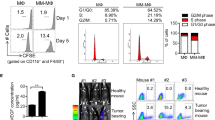Abstract
Background
Multiple myeloma (MM) is a common type of hematological malignancy. Cell adhesion molecule L1 (CHL1) can regulate the progression of a variety of tumors. However, the role of CHL1 is rarely reported in MM and the underlying mechanism is unclear.
Objective
The aim of this study is to uncover the possible effects of CHL1 on the autophagy and apoptosis of multiple myeloma (MM) cells and uncover the mechanism.
Results
We found the expression of CHL1 in MM patients was lower than that in healthy volunteers. CHL1 inhibited MM cell growth. In addition, CHL1 contributed to the apoptosis and autophagy of MM cells. Mechanically, we found CHL1 promoted autophagy and apoptosis of MM cells through regulating Hedgehog pathway.
Conclusion
We therefore thought CHL1may be a potential target for treating MM.






Similar content being viewed by others
Data availability
All data generated or analyzed during this study are included in this published article.
References
Alhallak K et al (2021) A pilot study of 3D tissue-engineered bone marrow culture as a tool to predict patient response to therapy in multiple myeloma. Sci Rep 11:19343
Andriandi Kamal AF (2019) Survival rate of multiple myeloma patients in Indonesia: a retrospective study in multiple myeloma at a single institution. Anna Med Surg 41:11–15
Bao L et al (2020) Hypercalcemia caused by humoral effects and bone damage indicate poor outcomes in newly diagnosed multiple myeloma patients. Cancer Med 9:8962–8969
Bertrand FE, Angus CW, Partis WJ, Sigounas G (2012) Developmental pathways in colon cancer: crosstalk between WNT, BMP, Hedgehog and Notch. Cell Cycle 11:4344–4351
Cai X et al (2020) Overexpression of close homolog of L1 enhances the chemosensitivity of lung cancer cells via inhibition of the Akt pathway. Oncol Lett 20:111
Chang KJ et al (2020) Arsenic trioxide inhibits the growth of cancer stem cells derived from small cell lung cancer by downregulating stem cell-maintenance factors and inducing apoptosis via the Hedgehog signaling blockade. Translat Lung Cancer Res 9:1379–1396
Chen J et al (2019) CHL1 suppresses tumor growth and metastasis in nasopharyngeal carcinoma by repressing PI3K/AKT signaling pathway via interaction with Integrin beta1 and Merlin. Int J Biol Sci 15:1802–1815
Chen Y et al (2021) Cell adhesion molecule L1 like plays a role in the pathogenesis of idiopathic hypogonadotropic hypogonadism. J Endocrinol Invest 44:1739–1751
Coleman EA et al (2011) Fatigue, sleep, pain, mood, and performance status in patients with multiple myeloma. Cancer Nurs 34:219–227
Diaz-delCastillo M et al (2021) Bone pain in multiple myeloma (BPMM)-A protocol for a prospective, longitudinal. Observat Study Cancers 13:223
Kataria H et al (2016) Small molecule agonists of cell adhesion molecule L1 Mimic L1 functions In Vivo. Mol Neurobiol 53:4461–4483
Kleene R et al (2021) Revisiting the proteolytic processing of cell adhesion molecule L1. J Neurochem 157:1102–1117
Li H et al (2020) TET1 downregulates epithelial-mesenchymal transition and chemoresistance in PDAC by demethylating CHL1 to inhibit the Hedgehog signaling pathway. Oncogene 39:5825–5838
Long MJ et al (2012) MicroRNA-10a targets CHL1 and promotes cell growth, migration and invasion in human cervical cancer cells. Cancer Lett 324:186–196
Luczkowska K et al (2021) microRNAs as the biomarkers of chemotherapy-induced peripheral neuropathy in patients with multiple myeloma. Leuk Lymphoma 62:2768–2776
Martin-Sanchez E et al (2017) CHL1 hypermethylation as a potential biomarker of poor prognosis in breast cancer. Oncotarget 8:15789–15801
Miriyala LKV, Avasthi D (2021) Cutaneous multiple myeloma. Cureus 13:e17779
Ognibene M, Pezzolo A (2020) Ezrin interacts with the tumor suppressor CHL1 and promotes neuronal differentiation of human neuroblastoma. PLoS ONE 15:e0244069
Ooashi N, Kamiguchi H (2009) The cell adhesion molecule L1 controls growth cone navigation via ankyrin(B)-dependent modulation of cyclic AMP. Neurosci Res 63:224–226
Sun F et al (2021) WDR26 and MTF2 are therapeutic targets in multiple myeloma. J Hematol Oncol 14:203
Tang B et al (2018) MicroRNA-324-5p regulates stemness, pathogenesis and sensitivity to bortezomib in multiple myeloma cells by targeting hedgehog signaling. Int J Cancer 142:109–120
Ungari M et al (2021) Combined renal proximal tubulopathy and crystal storing histiocytosis in a patient with kappa light chain multiple myeloma. Pathologica 113:285–293
Yan H et al (2019) Identification of key candidate genes and pathways in multiple myeloma by integrated bioinformatics analysis. J Cell Physiol 234:23785–23797
Zaal EA et al (2021) Targeting coenzyme Q10 synthesis overcomes bortezomib resistance in multiple myeloma. Molecular Omics. 18:19
Zhang Z et al (2020) GANT61 and valproic acid synergistically inhibited multiple myeloma cell proliferation via hedgehog signaling pathway. Med Sci Mon 26:e920541
Acknowledgements
Not applicable.
Funding
Not applicable.
Author information
Authors and Affiliations
Contributions
XG and YJ designed the study, supervised the data collection, XG analyzed the data, interpreted the data and prepared the manuscript for publication, YJ reviewed the draft of the manuscript. All authors have read and approved the manuscript.
Corresponding author
Ethics declarations
Conflict of interest
Xinyu Gao declares that he/she has no conflict of interest; author Yongfang Jiang declares that he/she has no conflict of interest.
Ethical approval
Ethical approval was obtained from the Ethics Committee of the Second Affiliated Hospital of Harbin Medical University (Approval No.KY2021-292).
Informed consent
Written informed consent was obtained from a legally authorized representative(s) for anonymized patient information to be published in this article.
Additional information
Publisher’s Note
Springer Nature remains neutral with regard to jurisdictional claims in published maps and institutional affiliations.
Supplementary Information
Rights and permissions
Springer Nature or its licensor (e.g. a society or other partner) holds exclusive rights to this article under a publishing agreement with the author(s) or other rightsholder(s); author self-archiving of the accepted manuscript version of this article is solely governed by the terms of such publishing agreement and applicable law.
About this article
Cite this article
Gao, X., Jiang, Y. CHL1 promotes autophagy and apoptosis of multiple myeloma cells via inhibiting the Hedgehog pathway. Mol. Cell. Toxicol. (2023). https://doi.org/10.1007/s13273-023-00382-x
Accepted:
Published:
DOI: https://doi.org/10.1007/s13273-023-00382-x





